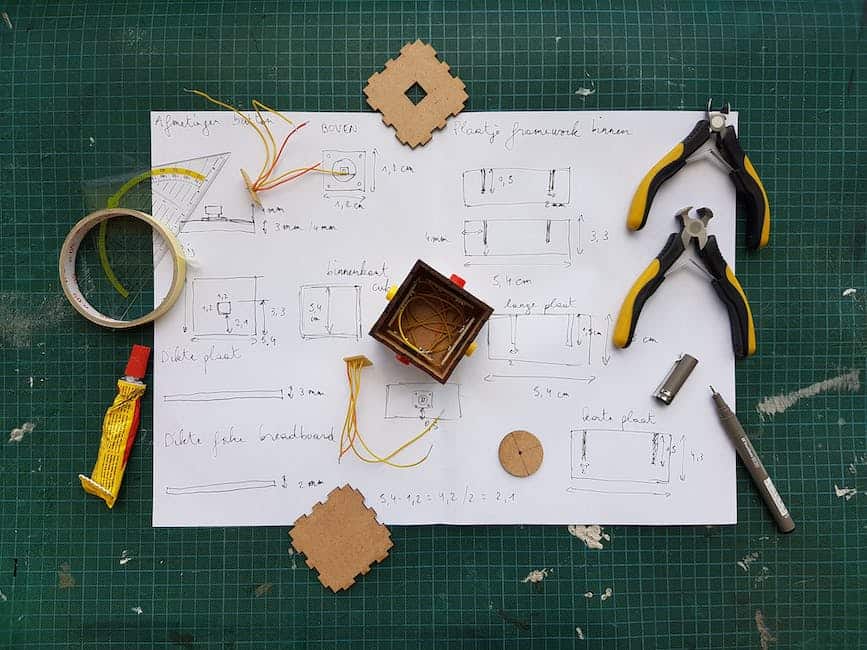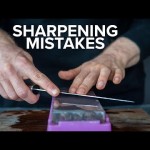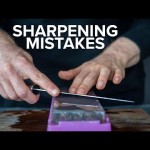
pexels photo 1178498

Having a sharp knife is essential for any kitchen. Whether you’re a professional chef or a home cook, having a sharp knife can make all the difference in the quality of your food. But how do you get a knife to that razor-sharp edge? The answer is simple: stropping. In this article, we’ll discuss the basics of stropping and how to use it to get a razor-sharp edge on your knife. We’ll also discuss the different types of strops and the best practices for stropping a knife. So, if you’re looking to get the most out of your knives, read on to learn how to strop a knife for a razor-sharp edge.
How to Achieve the Perfect Edge: Tips for Achieving a Razor Sharp Knife
Having a sharp knife is essential for any kitchen. A dull knife can be dangerous and can make cutting and slicing difficult. To ensure your knife is always sharp, it is important to learn how to achieve the perfect edge. Here are some tips for achieving a razor sharp knife.
1. Choose the Right Knife
The first step to achieving a razor sharp knife is to choose the right knife. Different knives are designed for different tasks, so it is important to select the right knife for the job. For example, a chef’s knife is great for chopping and slicing, while a paring knife is better for peeling and coring. Selecting the right knife for the job will make it easier to achieve a sharp edge.
2. Sharpen Regularly
It is important to sharpen your knife regularly to maintain a sharp edge. A sharpening stone is the best way to sharpen a knife, as it will help to keep the blade in good condition. To sharpen a knife, start by wetting the stone with water or oil. Then, hold the knife at a 20-degree angle and move it across the stone in a circular motion. Repeat this process on both sides of the blade until it is sharp.
3. Use a Honing Steel
In addition to sharpening your knife regularly, it is also important to use a honing steel. A honing steel is a metal rod that is used to realign the blade of a knife. To use a honing steel, hold the steel in one hand and the knife in the other. Then, draw the blade of the knife along the steel in a sweeping motion. This will help to keep the blade sharp and in good condition.
4. Store Properly
Finally, it is important to store your knife properly. A knife should always be stored in a safe place, such as a knife block or a drawer. This will help to protect the blade from damage and will also help to keep it sharp. It is also important to clean and dry the knife after each use to prevent rust and corrosion.
By following these tips, you can achieve the perfect edge and keep your knife razor sharp. With a sharp knife, you can easily and safely prepare food in the kitchen. So, take the time to sharpen and hone your knife regularly and store it properly to ensure it is always in top condition.
Sharpening Your Knife with a Razor Strop: A Step-by-Step Guide
Sharpening a knife is an important part of knife maintenance. A sharp knife is safer to use and will last longer. A razor strop is a great tool for sharpening a knife. It is easy to use and can help you get a sharp edge quickly. Here is a step-by-step guide to sharpening your knife with a razor strop.
Step 1: Prepare the Strop
Before you begin sharpening your knife, you need to prepare the strop. Start by cleaning the strop with a damp cloth. This will remove any dirt or debris that could interfere with the sharpening process. Once the strop is clean, apply a thin layer of stropping compound to one side. This will help to create a finer edge on your knife.
Step 2: Sharpen the Knife
Once the strop is prepared, you can begin sharpening your knife. Start by holding the knife at a 20-degree angle against the strop. Pull the knife away from you in a smooth, even motion. Make sure to keep the angle consistent throughout the stroke. Repeat this process on the other side of the blade. Do this 10-15 times on each side of the blade.
Step 3: Test the Edge
Once you have finished sharpening the knife, it is important to test the edge. To do this, you can use a piece of paper. Hold the paper in one hand and the knife in the other. Gently slice the paper with the knife. If the paper slices cleanly, then the edge is sharp. If the paper tears, then you need to repeat the sharpening process.
Step 4: Clean and Store the Knife
Once you have finished sharpening the knife, it is important to clean and store it properly. Start by wiping the blade with a damp cloth to remove any debris. Then, apply a light coat of oil to the blade to protect it from rust. Finally, store the knife in a safe place where it will not be damaged.
Sharpening your knife with a razor strop is a great way to keep your knife sharp and in good condition. With a little practice, you can easily get a sharp edge on your knife. Follow these steps and you will be able to sharpen your knife quickly and safely.
Discover the Optimal Angle for Sharpening Razor Blades
Sharpening razor blades is an important part of maintaining a clean shave. To get the best results, it is important to use the correct angle when sharpening. This article will explain the optimal angle for sharpening razor blades and provide tips on how to achieve it.
What is the Optimal Angle for Sharpening Razor Blades?
The optimal angle for sharpening razor blades is 15 to 20 degrees. This angle is the most effective for creating a sharp edge on the blade. It is important to maintain this angle throughout the sharpening process to ensure the best results.
How to Achieve the Optimal Angle
The best way to achieve the optimal angle for sharpening razor blades is to use a sharpening stone. A sharpening stone is a flat, abrasive surface that is used to sharpen blades. When using a sharpening stone, it is important to hold the blade at the correct angle. To do this, you can use a guide to help you maintain the correct angle. You can also use a honing guide, which is a device that helps you maintain the correct angle while sharpening.
Tips for Sharpening Razor Blades
When sharpening razor blades, it is important to use the correct angle and technique. Here are some tips to help you get the best results:
- Use a sharpening stone to sharpen the blade.
- Use a honing guide to maintain the correct angle.
- Sharpen the blade in a single direction.
- Use light pressure when sharpening.
- Clean the blade after sharpening.
Conclusion
Sharpening razor blades is an important part of maintaining a clean shave. To get the best results, it is important to use the correct angle when sharpening. The optimal angle for sharpening razor blades is 15 to 20 degrees. To achieve this angle, it is best to use a sharpening stone and a honing guide. Following these tips will help you get the best results when sharpening your razor blades.
Sharpening Your Knife: Tips for Achieving a Razor-Sharp Edge
Sharpening a knife is an essential skill for any chef or home cook. A sharp knife is safer and more efficient to use than a dull one, and it can make all the difference in the quality of your food. Here are some tips for sharpening your knife and achieving a razor-sharp edge.
Choose the Right Sharpening Tool
The first step in sharpening your knife is to choose the right sharpening tool. There are a variety of options available, including sharpening stones, electric sharpeners, and honing steels. Each has its own advantages and disadvantages, so it’s important to choose the one that best suits your needs.
Sharpen at the Right Angle
When sharpening your knife, it’s important to maintain the correct angle. Most knives have a 20-degree angle, so it’s important to keep the blade at this angle when sharpening. If you’re using a sharpening stone, you can use a guide to help you maintain the correct angle. If you’re using an electric sharpener, it will usually have an adjustable angle guide.
Use the Right Technique
Once you’ve chosen the right sharpening tool and angle, it’s time to start sharpening. The most important thing to remember is to use a consistent technique. Start at the heel of the blade and work your way to the tip, using a back-and-forth motion. Make sure to apply even pressure throughout the sharpening process.
Test the Edge
Once you’ve finished sharpening your knife, it’s important to test the edge. You can do this by slicing a piece of paper or running your finger along the edge. If the edge is sharp, it should easily slice through the paper or feel smooth to the touch. If it’s not sharp enough, you can repeat the sharpening process until you achieve the desired result.
Conclusion
Sharpening your knife is an important skill for any chef or home cook. By following these tips, you can achieve a razor-sharp edge and get the most out of your knife. With a sharp knife, you can prepare food more efficiently and safely.
Sharpening Your Knife Without a Stone: A Step-by-Step Guide
Sharpening a knife is an essential part of kitchen maintenance. A sharp knife is safer to use and will make your cooking tasks easier. While a sharpening stone is the traditional tool for sharpening a knife, it is possible to sharpen a knife without one. Here is a step-by-step guide to sharpening your knife without a stone.
Step 1: Gather Your Materials
You will need a few materials to sharpen your knife without a stone. You will need a piece of leather, a piece of wood, and some honing oil. The leather should be thick enough to provide a stable surface for sharpening. The wood should be hard and smooth. The honing oil will help lubricate the blade and protect it from damage.
Step 2: Prepare the Leather
Before you begin sharpening, you need to prepare the leather. Start by dampening the leather with a damp cloth. This will help the leather to grip the blade and provide a better surface for sharpening. Once the leather is damp, rub it with honing oil. This will help to lubricate the blade and protect it from damage.
Step 3: Place the Knife on the Leather
Once the leather is prepared, you can place the knife on it. Place the blade of the knife on the leather and hold it in place with your non-dominant hand. Make sure the blade is flat against the leather and that it is not angled.
Step 4: Sharpen the Knife
Now you can begin sharpening the knife. Start by drawing the blade across the leather in a smooth, even motion. Make sure to keep the blade flat against the leather and to use a light pressure. You should also make sure to keep the blade at the same angle throughout the sharpening process.
Step 5: Check the Edge
Once you have finished sharpening the blade, you should check the edge. To do this, place the blade against a piece of wood and press down lightly. If the blade is sharp, it should cut into the wood. If it does not, you will need to repeat the sharpening process.
Step 6: Clean and Store the Knife
Once you have finished sharpening the knife, you should clean and store it properly. Start by wiping the blade with a damp cloth to remove any honing oil or debris. Then, store the knife in a safe place where it will not be exposed to moisture or extreme temperatures.
Sharpening a knife without a stone is possible, but it does require some practice. With a few simple steps and the right materials, you can keep your knives sharp and ready for use.
DIY Knife Sharpening: Learn How to Make Your Knife Razor Sharp in the Comfort of Your Home
Sharpening a knife is an essential skill for any home cook. It’s also a great way to save money and time, as you can do it yourself in the comfort of your own home. With the right tools and techniques, you can make your knife razor sharp in no time. Here’s how to get started with DIY knife sharpening.
Gather the Right Tools
The first step in sharpening your knife is to gather the right tools. You’ll need a sharpening stone, a honing steel, and a cloth. A sharpening stone is a flat stone that is used to grind and hone the blade. A honing steel is a rod-shaped tool that is used to realign the blade’s edge. Finally, a cloth is used to clean the blade after sharpening.
Sharpen the Blade
Once you have the right tools, it’s time to sharpen the blade. Start by wetting the sharpening stone with water. Then, hold the blade at a 20-degree angle and move it across the stone in a circular motion. Make sure to keep the angle consistent as you move the blade.
com/wp-content/uploads/2023/03/pexels-photo-1178498.jpeg” title=”Sharpening a Knife: How to Strop a Knife for a Razor-Sharp Edge” alt=”Sharpening a Knife: How to Strop a Knife for a Razor-Sharp Edge”>
After a few passes, check the blade’s edge to see if it’s sharp. If not, repeat the process until it is.
Hone the Blade
Once the blade is sharp, it’s time to hone it. To do this, hold the honing steel at a 20-degree angle and move the blade across it in a circular motion. Make sure to keep the angle consistent as you move the blade.
com/wp-content/uploads/2023/03/pexels-photo-1178498.jpeg” title=”Sharpening a Knife: How to Strop a Knife for a Razor-Sharp Edge” alt=”Sharpening a Knife: How to Strop a Knife for a Razor-Sharp Edge”>
After a few passes, check the blade’s edge to see if it’s sharp. If not, repeat the process until it is.
Clean the Blade
Finally, use the cloth to clean the blade. This will remove any debris or residue that may have accumulated during the sharpening process. Once the blade is clean, it’s ready to use.
Conclusion
Sharpening a knife is an essential skill for any home cook. With the right tools and techniques, you can make your knife razor sharp in the comfort of your own home. Gather the right tools, sharpen the blade, hone the blade, and clean the blade, and you’ll be ready to use your knife in no time.
Achieving Professional-Level Sharpness at Home: How to Use a Stone to Sharpen Your Knife
Sharpening a knife is an essential skill for any home cook. A sharp knife is safer and more efficient to use than a dull one, and it can make all the difference in the quality of your food. While there are many ways to sharpen a knife, using a stone is one of the most effective and reliable methods. Here’s how to use a stone to sharpen your knife and achieve professional-level sharpness at home.
Gather Your Supplies
Before you begin, you’ll need to gather the supplies you’ll need to sharpen your knife. You’ll need a sharpening stone, a honing steel, a cloth, and a lubricant. The sharpening stone should be a medium-grit stone, such as a 1000-grit stone. The honing steel should be a fine-grit steel, such as a 6000-grit steel. The lubricant can be water or oil, depending on the type of stone you’re using. Finally, the cloth should be a soft, lint-free cloth.
Prepare the Stone
Once you’ve gathered your supplies, you’ll need to prepare the stone. If you’re using a water stone, you’ll need to soak it in water for at least 10 minutes. If you’re using an oil stone, you’ll need to lubricate it with oil. Once the stone is prepared, you’re ready to begin sharpening.
Sharpen the Knife
To sharpen the knife, hold the knife at a 20-degree angle to the stone. Start at the heel of the blade and draw the knife across the stone in a sweeping motion. Make sure to keep the angle consistent throughout the sharpening process. After each stroke, wipe the blade with the cloth to remove any metal shavings. Repeat this process on the other side of the blade. Once you’ve sharpened both sides of the blade, you’re ready to hone the blade.
Hone the Knife
To hone the blade, hold the honing steel at a 20-degree angle to the blade. Draw the blade across the steel in a sweeping motion. Make sure to keep the angle consistent throughout the honing process. After each stroke, wipe the blade with the cloth to remove any metal shavings. Repeat this process on the other side of the blade. Once you’ve honed both sides of the blade, you’re done.
Conclusion
Sharpening a knife with a stone is a simple and effective way to achieve professional-level sharpness at home. With the right supplies and a bit of practice, you can easily sharpen and hone your knives to perfection. So grab your supplies and get sharpening!
A Step-by-Step Guide to Sharpening Your Knife for a Razor-Sharp Edge
Having a sharp knife is essential for any kitchen. A dull knife can be dangerous and can make cutting and slicing difficult. Fortunately, sharpening your knife is a relatively simple process that can be done at home. Here is a step-by-step guide to sharpening your knife for a razor-sharp edge.
Step 1: Gather Your Supplies
Before you begin sharpening your knife, you will need to gather the necessary supplies. You will need a sharpening stone, a honing steel, and a cloth. You may also want to use a honing oil or water to lubricate the stone. Once you have all of your supplies, you are ready to begin.
Step 2: Prepare the Stone
Before you begin sharpening your knife, you will need to prepare the stone. If you are using an oil stone, you will need to apply a few drops of honing oil to the stone. If you are using a water stone, you will need to soak the stone in water for a few minutes. Once the stone is prepared, you are ready to begin sharpening.
Step 3: Sharpen the Knife
Once the stone is prepared, you can begin sharpening the knife. Start by placing the knife on the stone at a 20-degree angle. Then, using a back-and-forth motion, move the knife across the stone. Make sure to keep the angle consistent throughout the process. After a few passes, you should start to see a burr forming on the edge of the blade. This is an indication that the knife is sharpening.
Step 4: Hone the Knife
Once the knife is sharpened, you will need to hone it. To do this, use a honing steel. Place the honing steel on a flat surface and hold the knife at a 20-degree angle. Then, using a back-and-forth motion, move the knife across the steel. Make sure to keep the angle consistent throughout the process. After a few passes, you should start to see a burr forming on the edge of the blade. This is an indication that the knife is honing.
Step 5: Clean and Polish the Knife
Once the knife is honed, you will need to clean and polish it. To do this, use a cloth. Gently wipe the blade with the cloth to remove any debris or residue. Then, use a polishing compound to give the blade a glossy finish. Once the blade is clean and polished, your knife is ready to use.
Conclusion
Sharpening your knife is a relatively simple process that can be done at home. By following these steps, you can easily sharpen your knife for a razor-sharp edge. With a sharp knife, you can easily and safely cut and slice whatever you need.
Unlock the Potential of Your Kitchen Knife: Discover How Sharp It Can Get
Having a sharp kitchen knife is essential for any home cook. A dull knife can be dangerous and make it difficult to cut through food. But how do you know if your knife is sharp enough? And how can you make it even sharper? Here are some tips to help you unlock the potential of your kitchen knife and discover how sharp it can get.
Check the Edge
The first step to unlocking the potential of your kitchen knife is to check the edge. Run your finger along the blade and feel for any nicks or burrs. If you find any, it’s time to sharpen your knife. If the edge is smooth, your knife is already sharp enough.
Sharpen Your Knife
If your knife needs sharpening, there are a few different methods you can use. The most common is to use a sharpening stone. This is a flat stone with a coarse side and a fine side. Start with the coarse side and move to the fine side. You can also use a honing steel to realign the edge of your knife. This is a rod with a handle that you run along the blade. Finally, you can use an electric sharpener for a quick and easy way to sharpen your knife.
Maintain Your Knife
Once you’ve sharpened your knife, it’s important to maintain it. After each use, make sure to clean and dry your knife. This will help prevent rust and corrosion. You should also store your knife in a safe place, such as a knife block or a sheath. This will help protect the blade and keep it sharp for longer.
Conclusion
Unlocking the potential of your kitchen knife is essential for any home cook. By checking the edge, sharpening your knife, and maintaining it, you can discover how sharp it can get. With a sharp knife, you’ll be able to cut through food with ease and make cooking a breeze.
Sharpening Your Pocket Knife: A Step-by-Step Guide to Achieving Razor-Sharp Results
Sharpening a pocket knife is an essential skill for any outdoorsman or knife enthusiast. A sharp pocket knife can be used for a variety of tasks, from cutting rope to whittling wood. But, if your pocket knife is dull, it can be difficult to use and even dangerous. Fortunately, sharpening a pocket knife is a relatively simple process that can be done with a few basic tools. In this article, we’ll provide a step-by-step guide to sharpening your pocket knife and achieving razor-sharp results.
Step 1: Gather Your Supplies
The first step in sharpening your pocket knife is to gather the necessary supplies. You’ll need a sharpening stone, a honing oil, and a cloth. You may also want to use a honing guide to help you keep the blade at the correct angle. Once you have all of your supplies, you’re ready to begin.
Step 2: Prepare the Knife
Before you begin sharpening your pocket knife, you’ll need to prepare it. Start by cleaning the blade with a cloth and some warm, soapy water. This will remove any dirt or debris that could interfere with the sharpening process. Once the blade is clean, you’re ready to move on to the next step.
Step 3: Apply the Honing Oil
Once the blade is clean, you’ll need to apply some honing oil to the sharpening stone. This will help to lubricate the stone and prevent it from becoming clogged with metal particles. Apply a few drops of oil to the stone and spread it evenly with a cloth.
Step 4: Sharpen the Blade
Now it’s time to sharpen the blade. Start by placing the blade on the sharpening stone at a 20-degree angle. Then, using a back-and-forth motion, move the blade across the stone. If you’re using a honing guide, make sure to keep the blade in the guide as you sharpen. Continue this process until you’ve sharpened the entire blade.
Step 5: Test the Blade
Once you’ve finished sharpening the blade, it’s time to test it. Start by running your finger along the edge of the blade. If it feels sharp, you’re done. If not, repeat the sharpening process until the blade is as sharp as you’d like it to be.
Conclusion
Sharpening a pocket knife is a relatively simple process that can be done with a few basic tools. With a sharpening stone, honing oil, and a cloth, you can easily sharpen your pocket knife and achieve razor-sharp results. Just remember to keep the blade at a 20-degree angle and to test the blade after each sharpening session. With a little practice, you’ll be able to sharpen your pocket knife like a pro.
The Perfect Tool for Any Adventure: Razor Sharp Pocket Knife
A pocket knife is a must-have tool for any outdoor enthusiast. Whether you’re camping, hiking, fishing, or hunting, a pocket knife is an essential item to have in your arsenal. Not only is it a great tool for cutting rope, slicing food, and whittling wood, but it can also be used for self-defense in a pinch. A razor sharp pocket knife is the perfect tool for any adventure.
A pocket knife is a versatile tool that can be used for a variety of tasks. It can be used to cut rope, open cans, and even sharpen sticks. It can also be used to cut through thick brush and small branches. With a pocket knife, you can easily prepare food, build a shelter, and even defend yourself if necessary.
When choosing a pocket knife, it’s important to select one that is made of high-quality materials. Look for a knife with a strong blade that won’t easily break or bend. The handle should be comfortable to hold and the blade should be sharp enough to cut through tough materials. A razor sharp pocket knife is the perfect tool for any outdoor activity.
When using a pocket knife, it’s important to be safe. Always keep the blade away from your body and never use it to pry open cans or other objects. Make sure to keep the blade sharp and clean to ensure it’s in good working condition.
A pocket knife is an essential tool for any outdoor enthusiast. Whether you’re camping, hiking, fishing, or hunting, a razor sharp pocket knife is the perfect tool for any adventure. With a pocket knife, you can easily prepare food, build a shelter, and even defend yourself if necessary. Choose a high-quality knife and always use it safely to ensure you get the most out of your pocket knife.
Unlock the Secrets of Scary Sharp Knife Sharpening
Sharpening a knife is an essential skill for any chef or home cook. But if you want to take your knife sharpening to the next level, you need to learn the secrets of scary sharp knife sharpening. Scary sharp knife sharpening is a technique that uses a series of increasingly finer grits of sandpaper to create a razor-sharp edge on your knife. It’s a simple and inexpensive way to get your knives as sharp as possible.
The first step in scary sharp knife sharpening is to start with a coarse grit of sandpaper. This will remove any nicks or burrs on the blade and create a flat surface. Once the blade is flat, you can move on to a medium grit of sandpaper. This will further refine the edge and create a sharper edge. Finally, you can use a fine grit of sandpaper to polish the edge and create a razor-sharp edge.
Once you have the blade sharpened, you can use a honing steel to maintain the edge. A honing steel is a rod with a fine grit surface that is used to realign the edge of the blade. This will help keep the edge sharp and prevent it from becoming dull over time.
Scary sharp knife sharpening is a great way to get your knives as sharp as possible. It’s a simple and inexpensive technique that anyone can learn. With a little practice, you can unlock the secrets of scary sharp knife sharpening and get your knives as sharp as a professional chef.
Thank you for reading this article about sharpening a knife. We hope you now have a better understanding of how to strop a knife for a razor-sharp edge.
Goodbye and take care!












